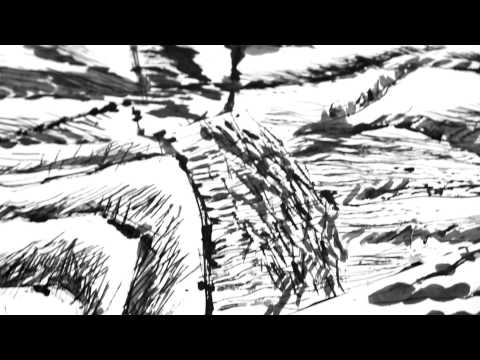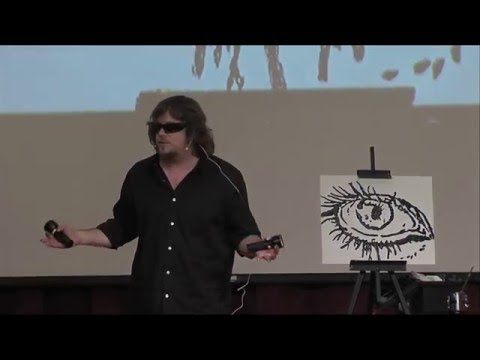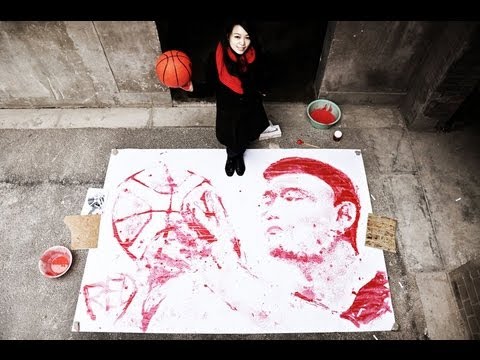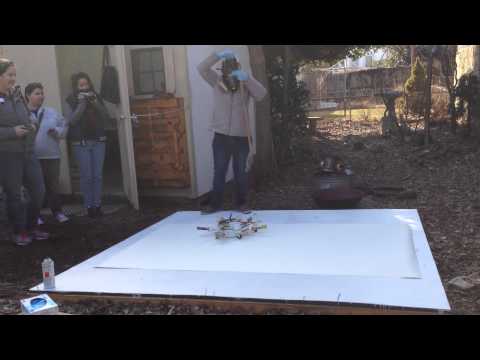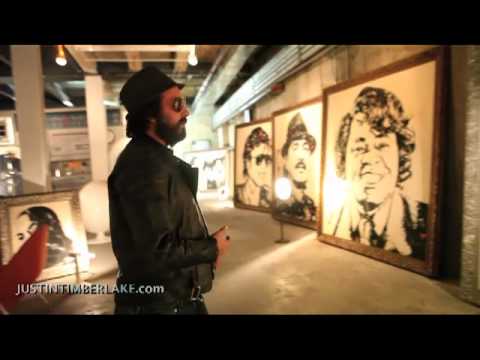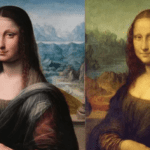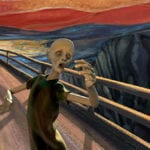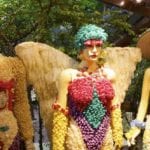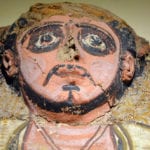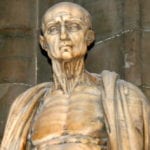10LandskatingHaisu Tian
If you find it hard to paint a picture with a brush, imagine how difficult it would be to create landscapes using rollerblades. But that’s exactly what’s done by Haisu Tian, a talented young artist from Fremont, California. She calls her technique “landskating.” Pots of ink are attached to the toes of her modified skates. When she moves, the ink flows over the front wheels onto xuan paper (also known as “rice paper”) to paint huge traditional Chinese ink paintings, which in this case are black-and-white landscapes. Invented in ancient China, xuan paper is the same soft, textured, pure white paper that’s used for Chinese calligraphy. But as delicate as the decorative writing or painting may seem, xuan paper is actually quite strong and resists many types of damage, including creasing and aging. Xuan paper also holds color well. Haisu began painting at three years old but only recently decided to incorporate skating into her work. “My whole body is involved, and I produce all kinds of ink landscapes,” says Haisu. “[Such] creation is full of power, speed, and rhythm. Though it is separated from the traditional technique of the painting brush, the vitality of traditional ink landscapes remains. I am so passionate about ink landscaping because it shows very rich emotions by means of simple forms.”
9Jet ArtPrincess Tarinan von Anhalt
Princess Tarinan von Anhalt creates abstract art by throwing plastic containers of paint in the air and using the wind and heat from a jet engine to weld the paint against a canvas. She calls her technique “jet art.” Von Anhalt has produced her artwork with Challenger, Citation, Gulfstream, and Lear business jets. Jet art can’t be done on a whim. It takes months to put a performance together—including securing approval from an airport, preparing the area with plastic tarps and platforms, arranging for the pilot and jet, and inviting 50–300 guests to the show. Von Anhalt has made her grand entrances by motorcycle and helicopter. People are paying her up to $50,000 apiece just to see it happen. Each finished painting will set you back from $25,000 to over $1 million. Von Anhalt calls the jet her “$11 million paintbrush.” This type of art is actually quite dangerous because the jet engine wind is much stronger than a hurricane. Standing between the jet and the canvas, she has to be careful not to get seared by the exhaust or drawn into the compressor. “One time during rehearsal, the pilot did not understand,” recalls von Anhalt. “I use one engine, generally not on full throttle, but this nice pilot did two engines on full throttle—almost takeoff power. I became The Flying Nun.” Nevertheless, she usually doesn’t worry about the danger when she’s in creation mode. Sometimes, she can predict how the finished painting will look. Other times, it’s a complete surprise created by the direction of the wind. “That’s the emotion,” she says. “It’s an addiction. And how do you describe that? It’s better than anything else.”
8Fabric PaintJohn Bramblitt
John Bramblitt didn’t become a painter until after he became functionally blind due to complications from epilepsy. His loss of sight began when he was 11, gradually worsening because of seizures until he couldn’t see anything except light and dark by 30 years old. He suffered from significant depression after he lost his sight. “All of the hopes and dreams that I had for my life; all of the plans for what I would do after I graduated school were gone,” Bramblitt said. “I was not only depressed, but in mourning.” But at his lowest point, he vowed to bring color back to his life using fabric paint that has raised edges. He can tell which colors he’s using by Braille on the tubes, often mixing colors together by how they feel in his hands. Bramblitt starts with a mental image then forms outlines that he can feel on the canvas with fabric paint. His finished works express strong emotion through the use of vibrant colors. He also creates remarkably accurate portraits, like the one he did for pro skateboarder Tony Hawk, just by feeling someone’s face.
7Basketball ArtHong Yi
Born in Malaysia, Hong Yi, who prefers to be called “Red,” is sometimes referred to as “the artist who loves to paint but not with a paintbrush.” In 2012, she created a portrait of famous basketball star, Yao Ming, with a basketball and a bucket of red paint. As a substitute for paintbrushes when she creates portraits, she likes to use the tools that helped her subjects become famous. In Yao Ming’s case, that’s a basketball. For Chinese artist and activist Ai Weiwei, it was real sunflower seeds because his Tate Modern exhibit consisted of hand-crafted porcelain pieces called Sunflower Seeds. Hong used a soccer ball guided by her feet to paint a trio of football stars: Christiano Ronaldo, Neymar, and Lionel Messi. According to Hong, she started using alternate painting tools because she didn’t want to ship her paintbrushes from Australia, where she was living at the time, to Shanghai, where she took a job with an architecture firm. She also didn’t want to spend the money for expensive new paintbrushes. Hong likes to work outside where people can watch her. She always records her creation process so she can share it through social media.
6 Auto DrawingIan Cook
Using the pseudonym “PopBangColor,” British artist Ian Cook creates car art by driving remote-controlled cars through paint on a canvas. Sometimes, he just uses tire treads to fill in the areas of the canvas with paint. Growing up in the West Midlands of England, Cook liked the auto plants in the area, but he absolutely loved racing cars. When he got his Fine Art degree from Winchester School of Fine Art, he was soon able to meld his interests in art and cars. It all came together when his girlfriend bought him a remote-controlled car as a Christmas present and told him not to get paint on it. He didn’t listen to her, although he always cleaned the paint off the car before she saw it. Eventually, Cook dumped the girl, but he kept the car. Testing different painting techniques with the tires, he discovered that the car tires had unique brushstrokes. Soon, he was able to produce intricate pictures in a style he named “popbang.” He likes to keep his art simple without any hidden agenda. “I once did a sculpture made from pieces of all my old diecast cars, arranged by color,” says Cook. “Iraq had recently been invaded when I put the sculpture on display, and everybody was analyzing it saying, ‘Is it about [a] car bomb? The horrors of suicide bombers?’ I said, ‘Uh, no, it’s cutting up your toy cars and sorting them by color.’ ” Apparently, that’s what the big car companies want because he does a lot of events for them. Some of his customers include Dunlop, Ferrari, Ford Racing, Jaguar, and VW WRC.
5Fireworks PaintingRosemarie Fiore
Rosemarie Fiore creates abstract art using the colored smoke of fireworks as her paint. “My drawings are created by containing and controlling firework explosions,” she says. “I bomb blank sheets of [heavyweight] paper with different fireworks, including color smoke bombs, jumping jacks, monster balls, rings of fire, and lasers. As I work, I create imagery by controlling the chaotic nature of the explosions in upside-down containers.” Those containers, often cans, produce vibrant circles of color as she moves them along the paper. Fiore creates lines when she drags a sparkler over the paper with a stick. Burn marks blend in with the color. Her works are quite large, sometimes 2 meters (7 ft) wide or more. Fiore likes to layer her compositions, making a collage that is then bombed with fireworks again for a more complex design with overlapping disks of color. When creating her masterpieces, she’s used a lot of different equipment, including a lawnmower, an altered floor polisher, and a windshield wiper. But the strangest contraption was the octopus-like Scrambler, a spinning amusement park ride with many arms. When working, Fiore has to wear protective headgear because it can be quite dangerous. She developed this method after watching fireworks leave spinning marks on a cement floor as they exploded.
4Vinyl Record PortraitsMr. Brainwash
Thierry Guetta, also known as “Mr. Brainwash,” is a controversial French filmmaker and a Los Angeles street artist. Not everyone likes his work. Some people think he’s actually the pseudonymous graffiti artist Banksy. The Banksy documentary Exit Through The Gift Shop, however, portrays him as an idiot who becomes a successful artist after his friendship with various street artists convinces a gullible public that he’s a genius. If you’re wondering how Mr. Brainwash got his name, the artist chose it himself. He believes everything in life is about brainwashing, including the images he creates. Plus, he thought it sounded cool. Mr. Brainwash believes in taking care of the environment. He recycles trash like old tires and TVs into art. One of his unique and most popular types of art is vinyl record portraits. He smashes the records into hundreds, perhaps thousands, of small pieces and uses them to produce portraits of icons from the music world and elsewhere. He also mixes in colorful record labels and broken CDs. “I wanted to show different faces of people—just normal people—who ended up with extraordinary things because they believed in what they wanted to do,” says Mr. Brainwash. “It’s delivering a message that I want to communicate [to the audience] that anything is possible.” Mr. Brainwash also produces street art. He created the cover for a Madonna album but lost a copyright infringement case when a photographer sued him for creating a piece of art too close to the photographer’s original picture.
3Lip ArtNatalie Irish
Natalie Irish is one talented kisser. Using her lips as a paintbrush and lipstick as the paint, she’s able to create incredible portraits by kissing the faces of her favorite celebrities onto a blank canvas, a technique she calls “lip art.” She first tried this method of painting over 10 years ago but became much more motivated to succeed when she left her job at a veterinary clinic in Houston in 2010. Lip art is a derivative of thumbprint painting that Irish learned years ago in high school. “In 2001, I was putting on makeup to go out one night and see a band,” explains Irish. “I blotted my lips on a bit of tissue and got the idea of using lips in the same way as the thumbprints, in the spirit of pointillism.” It takes her a couple of weeks and up to three tubes of lipstick to complete each portrait. She’s kissed pictures of Kate Middleton, Jimi Hendrix, and Marilyn Monroe into existence. However, although it may sound like fun to kiss for a living, she often gets chapped lips and eyestrain as unwanted side effects of the job. She uses a lot of lip balm and petroleum jelly to keep her puckered lips smooth. As to her choice of paint, Irish says, “I use everything from designer brands, to Dollar Store stuff, and even theater makeup. I make lots of my own lipsticks and can create whatever colors I desire.” Irish is also committed to helping charitable causes. As a Type I diabetic who was diagnosed in high school, she volunteers her time and artwork to the Juvenile Diabetes Research Foundation. She’s also a volunteer for the Youth Leadership Council in Houston.
2Chicken Eggshell ArtworkBen Tre
We’ve previously discussed how engraving and coloring ostrich eggshells was an early form of art for our ancient ancestors. The designs were both decorative and symbolic to Stone Age cultures. Ostrich eggshells are hard and about 2–3 millimeters (0.8–0.12 in) thick. They’d have to be if an ostrich is going to sit on them. But that also means they’re easier than chicken eggshells to engrave without breaking. For comparison, chicken eggshells are only about 0.3–0.4 millimeters (0.01–0.02 inches) thick. They’re fragile. That’s why it’s so mind-blowing that Ben Tre from Vietnam can use a dentist’s drill to carve inscriptions, landscapes, and celebrity portraits in amazing detail on chicken eggshells. He’s already carved Albert Einstein, Karl Marx, and Queen Elizabeth II. Ben doesn’t treat the eggshells in any way, so these masterpieces can be cracked easily. Surprisingly, they still look good even when broken. It can take anywhere from three hours for a landscape to as long as two days for a portrait. Ben encases them in glass for worried patrons. Sometimes, he also uses LED-illuminated wooden bases to highlight the eggshells for a stunning effect that transforms them into colorful miniature lamps.
1Hitofude RyuuDragon Art Kousyuuya
Dragon Art Kousyuuya is a shop in Nikko, Japan, that specializes in creating personalized, one-stroke dragon art for customers right in front of them. It’s called “Hitofude Ryuu,” which is Japanese for “dragon with one stroke.” The head of the dragon is painted separately in several small strokes with a smaller paintbrush. But the multi-colored curving body is completed in one, long, elegant stroke with a dedicated tool called a sumie brush. According to a flyer in the shop, “Dragons are considered to be similar to guardian angels. They are talismans against evil and bring good luck. For ages, they have [adorned] Shinto shrines and temples.” Pictures of dragons are supposed to bring the same good fortune. Customers have a choice of sizes, colors, designs, and kanji characters for their dragon art. Kanji is a type of Japanese writing that uses Chinese characters with different meanings such as good luck and protection. Certain colors are also considered to be luckier, but you’ll have to pay more for them.
